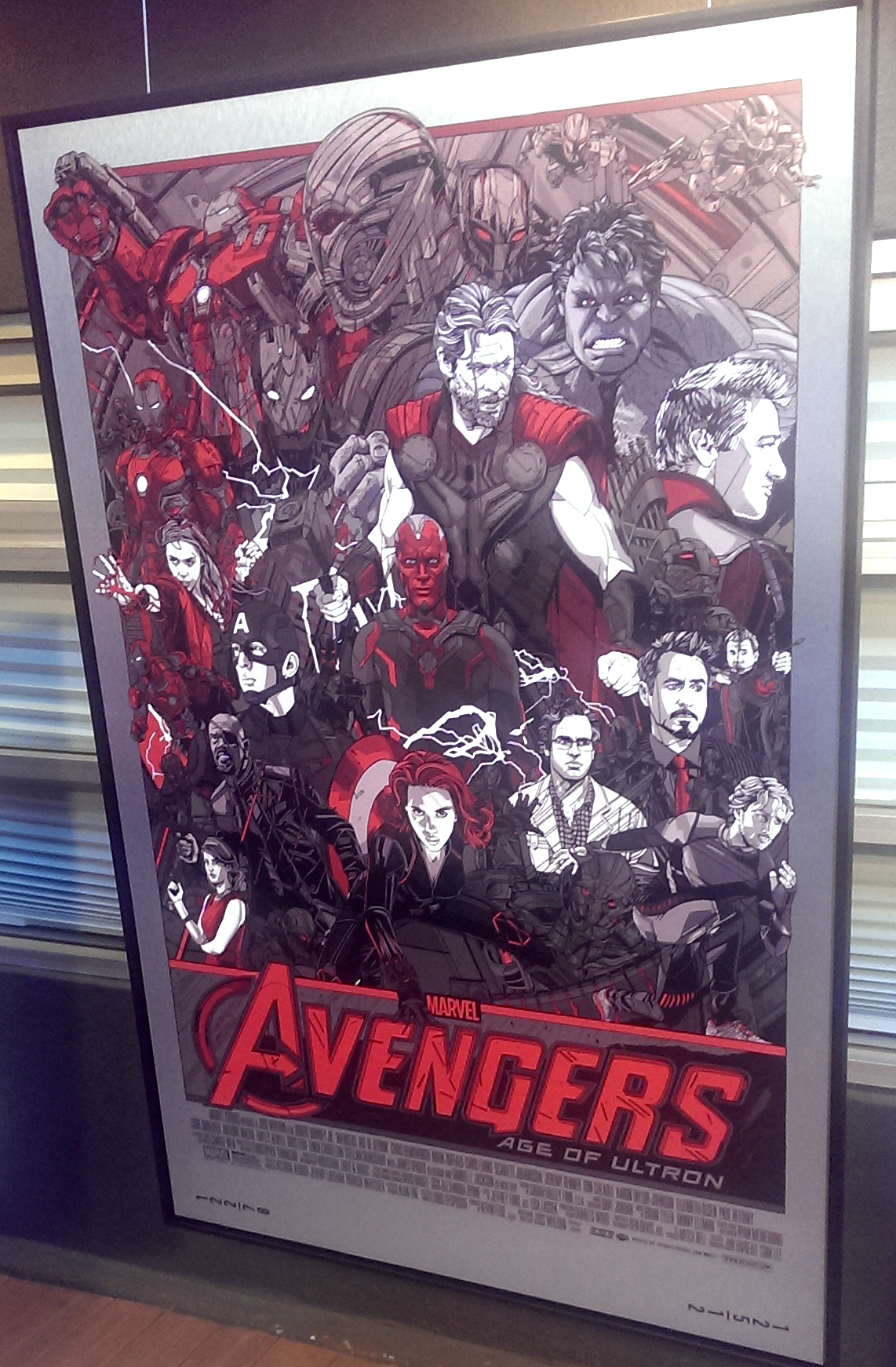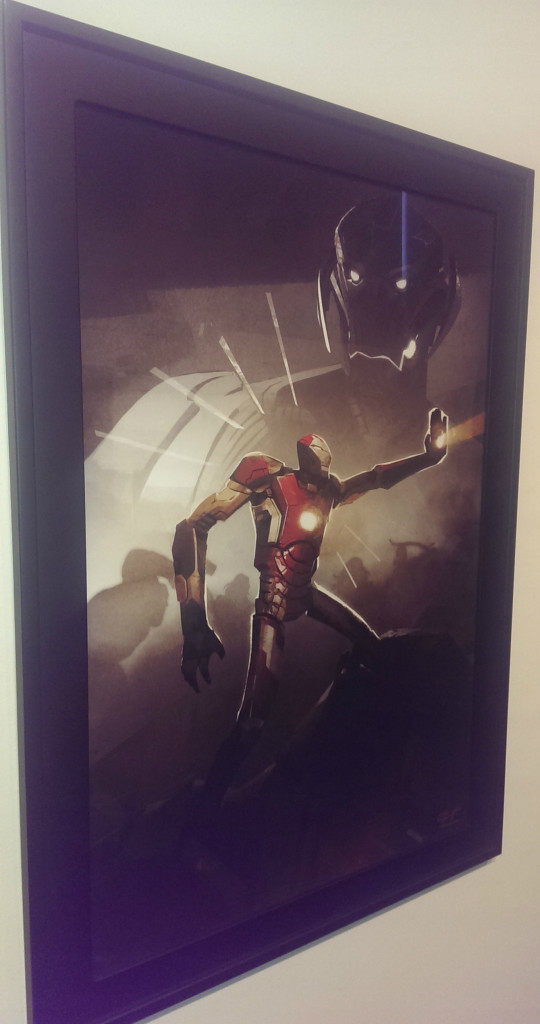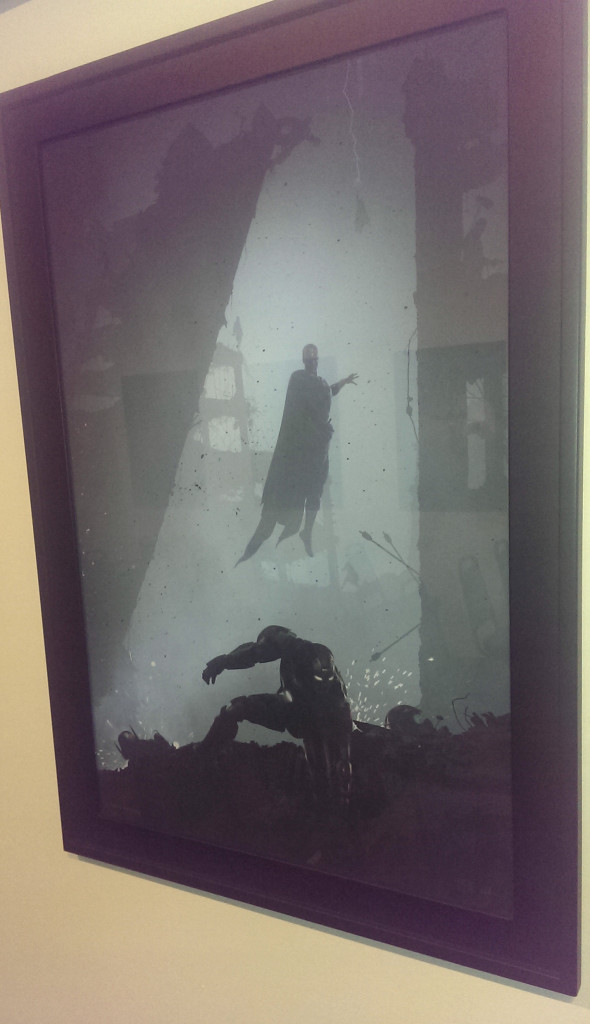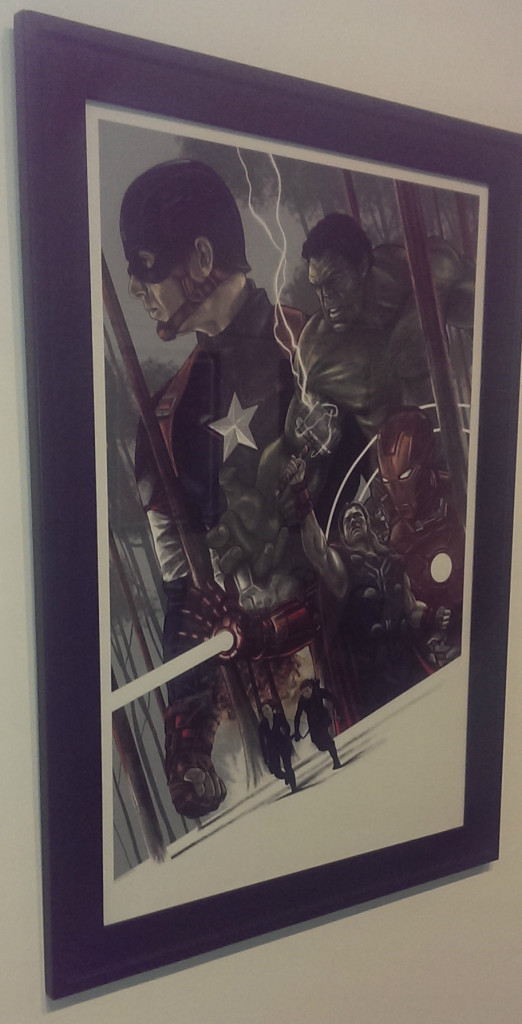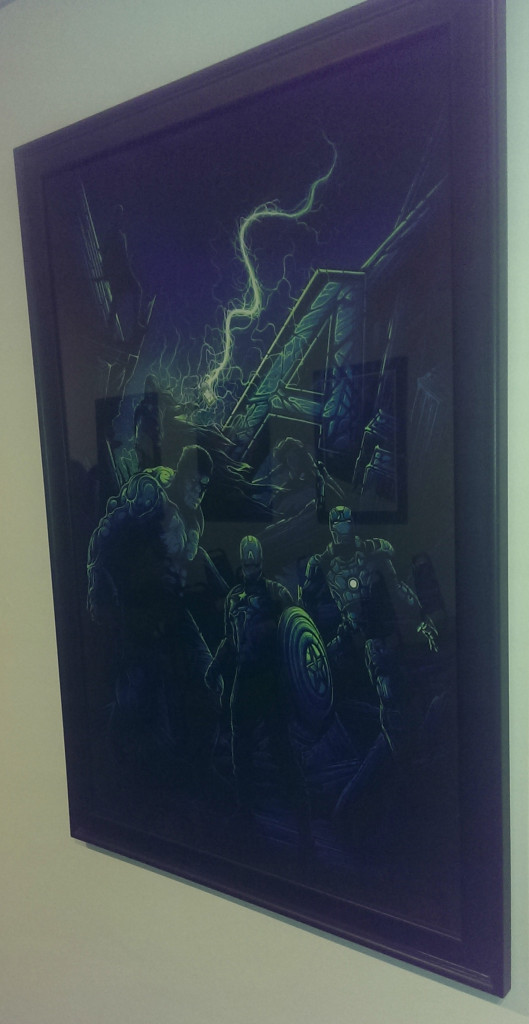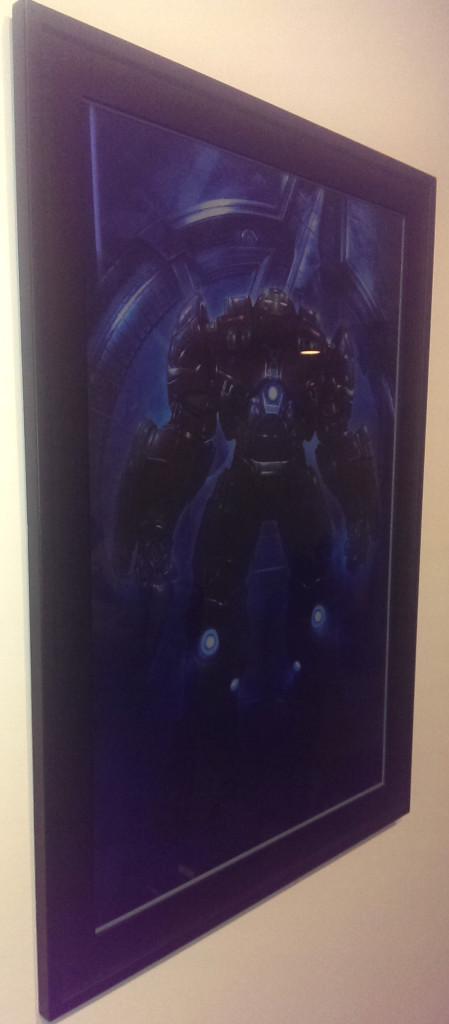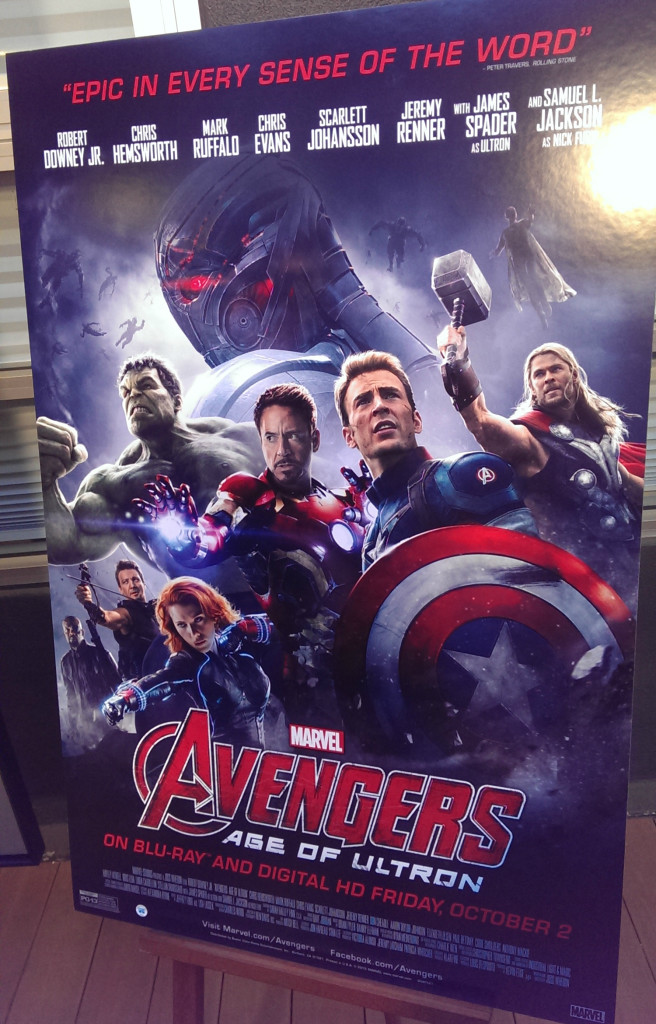14 Things We Learned From Marvel’s Kevin Feige and Jeremy Latcham at an Age of Ultron Art Show
“Does everyone get a poster, or just the person with the nerdiest question? Because if it was, sir, it’d be you.”
Marvel Studios head Kevin Feige is sitting in a small art gallery in West L.A. – the Hero Complex gallery, even – among multiple alternate posters for Avengers: Age of Ultron. And I have just asked him whether the gauntlet Thanos picks up during the mid-credits scene is the same one from Odin’s treasure room, and if so, whether we’ll see how he relocated it.
“It’s a good, good question. I might as well answer it, because you asked it, which I like. It is not the same one.”
Adds Jeremy Latcham, senior VP of production, who is sitting beside Feige, “But which do you think is the real one?”
This is perhaps the most specific tidbit to be learned during an evening in which we also screened some of the Blu-ray extras (Chris Hemsworth really goes psycho as a demonically possessed Thor in the extended cave scene), and for about 25 minutes, were able to ask Feige and Latcham anything. Obviously they’re not going to give out big spoilers, but in broad strokes, those of us in attendance did learn a few things about how the next movies are shaping up (the answers below come from a group interview).
[I also took picture of all the posters – as they were under glass and brightly lit it was hard to avoid reflections altogether, but I did what I could with the equipment I had.]
1. Tony Stark Can Even Screw up Responsibility.
Feige: Even Tony can be self-aware enough to go, “Maybe if I’d shared my plans with somebody, this might not happen.” And I think we are seeing a Tony that is trying to be more responsible, and there are things that happen between the movies that we learn about in Civil War that make that even more personal, and of course it’s the exact same moment that Captain America’s come to a point, and we encounter HYDRA, and we encounter the world security council, and he says we can’t listen to anybody else – that’s how corruption begins. And they don’t get along.
Latcham: I thing it’s a fun thing to watch a character grow up over the course of all these movies, and where’s the line? I think it will be fun to see in the next one.
2. Every Gauntlet Must Get Stoned.
Feige: You will see the other two [Infinity Stones] sometime in Phase 3, for sure – there’s a gauntlet that needs to be filled. It really was Iron Man 2 and building the architecture of the entirety of Phase 1 that that started to come about, and the Tesseract not only being the thing that ties all of Phase 1 together, but that could be a part of all of the other things that ties Phase 2 together. So I won’t say it was all perfectly planned and laid out in 2009, but that was the genesis of it.
Latcham: I remember having a conversation on the set – we had the propmaster drawing the book that Tony Stark starts flipping through, he’s going through all his father’s stuff. And I remember trying to explain to the propmaster, “No, no, this cube you’re drawing is really important, so it needs to be a certain way because that’s gonna matter later.”
Feige: Howard Stark says on that film that Tony’s watching in Iron Man 2, “All you need to know is right in front of you” – when we’re on that page.
3. Who Gets the Family Jewels?
Feige: Some of it comes from the source material – the Cosmic Cube was always very important for Red Skull and Captain America. We always knew in this film, Age of Ultron, that there was one in Loki’s scepter and that was going to end up in Vision’s head. And some of the other ones, like the Orb, come out of structural plot needs sometimes for a MacGuffin, and a filmmaker will say, “Well, there’s this orb…” and we’ll say okay, let’s put something inside that orb and have it tie in to the larger environment.
Latcham: One of the keys is to let the filmmakers go make the movie they want to make, and not let too much of the craziness of the world get in the way of it, and then afterward we can look at it and go let’s make sure everything lines up now, and do any correction. But I think the main thing is to make every film stand on its own and be as fun as possible. Try do the housekeeping of building a bigger universe, but also make sure we’re making a fun movie.
4. Who Tells the Story?
Feige: We always usually have the kernel of an idea of what we want a story to be, or even just the tonality of a particular movie to be. We’re hiring a lot of filmmakers right now, and it really comes down to numerous meetings: I guess Jon Watts is the most recent one on Spider-Man – numerous meetings where we pitch them what we think the movie could be, and then we start a discussion, and if over the course of three or four or five meetings they make it way better, then we’ll be initially skewing to them.
5. Do They Already Know How It All Ends?
Feige: Yes, in broad strokes. Sometimes in super-specific things. But for the most part in broad strokes that are broad enough and loose enough that if, through the development of four or five movies before we get to the culminations, we still have room to sway, and to move, and to go and to surprise ourselves in places that we end up. So that all the movies, when we finish, can feel like they were all interconnected.
6. Where Do You Go After an Infinity War?
Latcham: I think it definitely is an end to some version of the team that we’ve come to know as the Avengers. Who knows exactly what’s going to happen yet in that film, but I think that this version of that team – and we start to hint at it at the end of Age of Ultron – will be evolving. And one of the things we love from the comics is that the roster’s always changing, new people are coming on to the team, and you can pick up an Avengers book ten years later and you don’t recognize the people on the cover. But the ideals that make the Avengers the Avengers still exist, and i think that’s part of what this culmination will be: we’re seeing this version of the team doing this thing to save the universe, the galaxy, however you want to put it – and then we’ll kind of see where that goes. It’s not the end of the Marvel Cinematic Universe, but I think it is the end of part of it, for sure. And we’re still trying to sort out which parts.
7. Why a Captain Marvel Cameo Didn’t Happen.
Feige: It might have been in one draft, and we shot a plate and the thought was maybe we would add her in there [to the final scene]. But the truth is it didn’t seem appropriate to just have this new person in a new costume literally come out of nowhere at the end of this story, and would have been a disservice to what, by the time the movie was coming out, people already knew was coming anyway in a way we could really do it justice.
Latcham: In really early development, there was a notion that there’d be a TON of new people, and then it was like, we haven’t really introduced them, we don’t know where they’re gonna come from. Joss did not love that idea. It was an early discussion, that kind of became just Captain Marvel, and then that felt weird, to have one new person and the audience go “What?”
Feige: And also when the subtext was – what does Cap say? They’re not the ’27 Yankees. If Captain Marvel’s there, what are we saying about her? The notion that they – Wanda, Vision, to a lesser extent Falcon, Rhodey – need to learn what it means to be a team, even if it’s the most dysfunctional team in the history of teams.
8. Tony’s Seen the Future, and It May Be. He’s Seen the Future, It Needs Work.
Latcham: The question going forward with Infinity War is were those literal visions, is that your worst fears being projected at you, is that a prediction of the future, or is that like a sense of impending doom that haunts you and keeps you awake at night, and I think that’ll be something we have to explore in Infinity War, to figure out how literal or not those are. If I was to guess, it’s more [Tony’s] fear – that other people pay the cost for what he’s done.
9. Why Civil War Is Not Avengers 3.
Feige: It is very much Cap’s story, it is very much a sequel to The Winter Soldier, and as that conflict builds, it is representative of the conflict between Cap and Tony. And there were a lot of characters in The Winter Soldier, but it felt like a singular and relatively simple thriller. Cap in Civil War follows in that same way – it’s something the Russos pride themselves on, and the screenwriters, Chris Markus and Stephen McFeely are excellent at giving each character just enough. It’s not a full arc for everybody – it’s just enough so that their presence is felt and is important, but that the very clear and single story that is being told is being served at all times.
10. Where Are the Marvel TV Heroes in All This?
Feige: I think that’s inevitable at some point. As w’re plotting the movies going forward and the shows, the schedules do not quite match up. It’s easier for them – they’re more nimble and faster and produce things quicker than we do, which is one of the main reasons you see the repercussions of Winter Soldier, or Age of Ultron in the shows. But going forward, and certainly if you see more shows casting such great actors, that that may occur. A lot of it is by the time we start doing a movie, maybe midway through a season, by the time the movie comes out they’d be done with the second and third season. So finding the timing on that is not always easy.
11. Is Spider-Man’s Late Arrival a Problem?
Feige: I don’t know if it’s late in the game. I think Vision and Wanda have just showed up and play an important part, Black Panther’s showing up, as you know. It’s not about when you show up; it’s about what you do. The most important thing is the stand-alone movie. It’s re-launching Spider-Man with a new storyline as he fits into this universe; that is job #1 for us. The connectivity is great, but it doesn’t drive the train. That being said, this has been a dream of ours for a long time, and we always had contingency plans – are we gonna be able to make another deal with this actor? If so, we’re gonna do this. If not, we’re gonna do this. If we get the rights to a certain character, that’d be great. We’ve always operated with various alternate timelines.
12. How About the Guardians of the Galaxy?
Feige: It’s a good question, and Thanos, clearly, and the Infinity Stones are the link between all those movies and especially Guardians, so I do think there’ll be more crossover into that sector of the Marvel – literal – universe. When and if those specific characters start switching remains to be seen. The Guardians 2 team just left for Atlanta on Monday to start that movie, so all of the Guardians effort and thought is going into Volume 2, which by the way is shaping up extremely nicely.
[At this point, Feige is asked about Howard the Duck]
Would he want to come to Earth? It didn’t work out for him so well last time he came to Earth. Why does he have to go anywhere?
13. Casting a Wide Net.
Feige: I think there’ll be quite a slew of casting announcements over the next few months. Before the end of the year, I think, on [Guardians 2 and Dr. Strange] and some other films.
14. So What About That Whole Deal With Black Widow Being Sterile in the Last Movie? And What About Future Diversity?
Feige: If Joss were here, he’d tell you all about that, what the story of Black Widow was, and what she was CLEARLY saying in the scene in that movie. But there’s always that pressure, with all the characters, when you’re dealing as I have for many many years with characters that are this loved and this respected in one form. You know, when I started, at the dawn of Internet feedback and talkback, it was “X-Men, you know it’s gonna suck because it’s a Marvel movie.” That was the sentiment based on what went before that. So there’s always been pressure – “Let’s not screw it up” – so that would exist with Black Panther and Captain Marvel just as it does with Spider-Man, just as it does with Iron Man or anybody else. And then there’s the added responsibility and pressure of just staying current with the times, of representing on that big screen what exists in the world around us, and that’s one of the things we’re most excited to do, as the comics have done a good job of doing, and even if you look back in the ’60s being ahead of the curve. We want the movies to get to the point where they’re ahead of the curve on all those issues as well, and I think we’ll get there sooner than you think.


